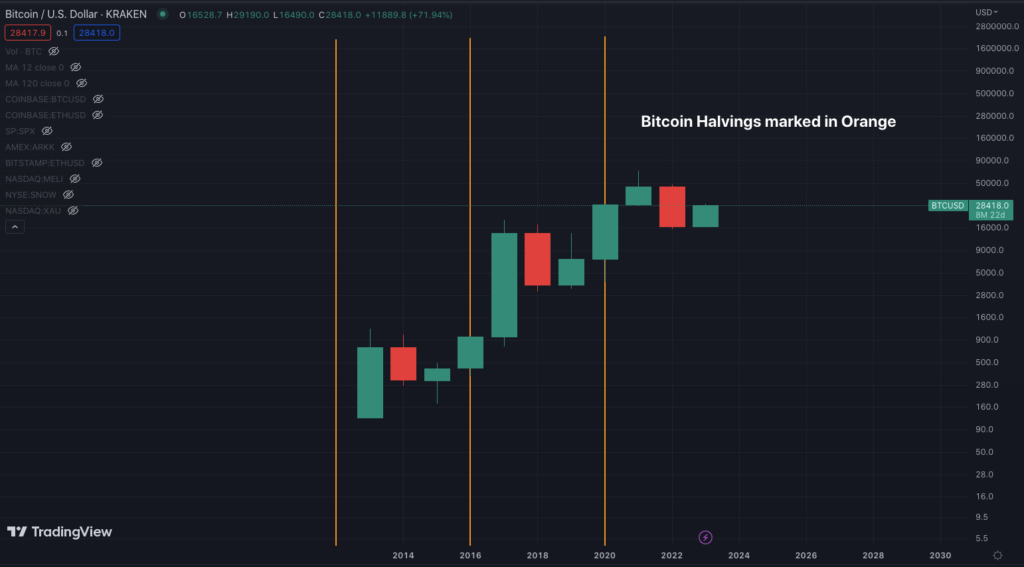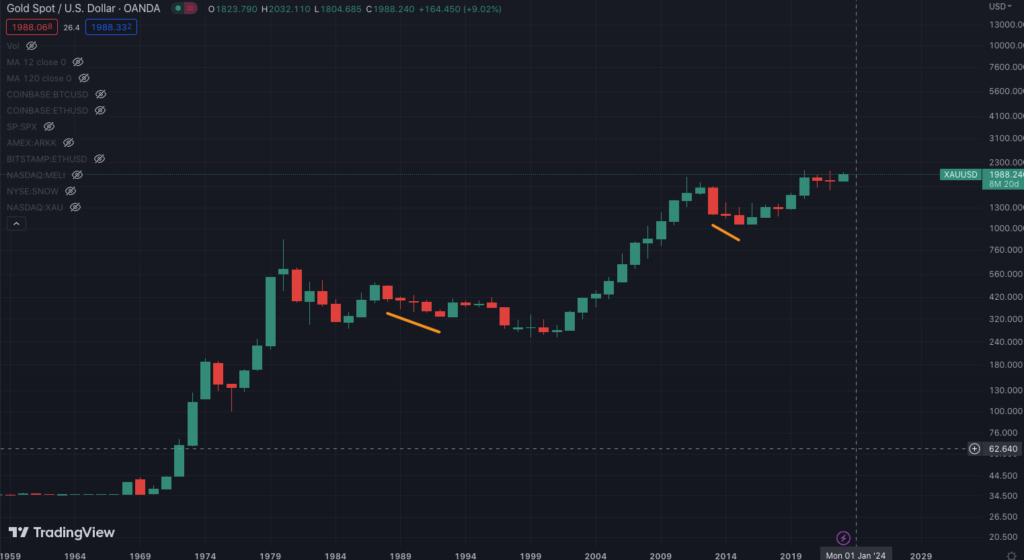Since the very beginning Bitcoin has been a volatile asset and so have been the hedge funds that invested in the cryptocurrency space. There have been prolonged periods of price appreciation followed by sharp and often enduring price declines. Bitcoin investors typically use moving averages in order to identify whether Bitcoin is in a bull or a bear market.
The Bitcoin Halving
The Bitcoin Halving is an important parameter defining the monetary properties of Bitcoin. With the Bitcoin Halving the number of Bitcoins issued to miners gets reduced by half. This is written in the code of the Bitcoin blockchain and based on the Halving schedule the total number of Bitcoins is restricted to 21 million. The Bitcoin Halving is happening after every 210,000 blocks mined which corresponds to roughly every four calendar years. This is projected to remain unchanged until the last Bitcoin will be mined which is forecasted to occur in the year 2140. After that point in time miners shall be rewarded solely through transaction fees for validating the Bitcoin blockchain.
Besides the Halving the number of coins lost increases over time. Industry observers estimate that potentially between 10% and 20% of all Bitcoins are lost. This number is still gradually increasing as not all Bitcoin investors that manage their Bitcoins in self custody have sound operational security practices implemented. Losing access to their funds is one of the reasons why for some investors it is better to invest in dedicated investment vehicles versus holding their cryptocurrencies in self custody. Lost Bitcoins over time further increase the scarcity of the digital assets along with the Halving that is written into the code.
The Halving and its occurrence every four years provides the narrative for the Bitcoin four year cycle. Typically the reduction in supply of Bitcoin has caused the price of Bitcoin to increase in the year following the Halving.

As it can be seen on the yearly log chart so far Bitcoin has never returned two consecutive years of negative returns. This means that Bitcoin has never entered a prolonged multi year bear market as seen in other asset classes such as gold.
Bitcoin as Digital Gold
Bitcoin is commonly referred to as digital gold among investors. It has many of the desirable properties of gold such as scarcity and fungibility while additionally it is easily divisible and transactable. Several investors of Bitcoin believe that once the digital currency reaches a higher degree of adoption and maturity it will experience a multi-year bear market just as gold.
Since the convertibility of the US Dollar to gold ended in 1971 gold has experienced two multi year bear markets that went on for more than two years. The first one occurred between 1988 and 1992 over a period of 5 years with a price decline of roughly 33%. The second one occurred between 2013 and 2016 and saw a price decline of almost 40%.

However, it was typically parabolic rises that set the foundation for gold’s multi year bear market. So far Bitcoin has not seen sufficient adoption and a spectacular multi year blow off tops that would justify a multi year bear market. According to a survey conducted by Morning Consult only 20% of Americans own cryptocurrencies. Therefore, most likely we will see another substantial adoption cycle and bull market before the price of Bitcoin will eventually decline for several years in a row.
How to Measure a Bitcoin Cycle?
Among investors there are three different ways to measure a Bitcoin cycle.
- Cycle Peak to Cycle Peak: Investors that look at bull markets often are focussed on all time highs and the peak of market cycles. The last Bitcoin all time high occurred in November 2021 and was preceded by the December 2017 all time high. The time between the all time highs was four years.
- Cycle Low to Cycle Low: Other investors believe that a cycle should be measured from one low to the next. The most recent Bitcoin low occurred in November 2022 and was preceded by the low in December 2018. This means the latest Bitcoin market cycle measured from low to low had a duration of 4 years.
- Halving to Halving: The Bitcoin Halvings occurred in November 2012, July 2016 and May 2020. The price of Bitcoin increased by 4,500% between the 2012 and 2016 Halving while it increased by around 1,300% between the 2016 and 2020 Halving.
No matter if Bitcoin Cycles are measured from peak to peak or low to low or alternatively through Halving cycles the Bitcoin Cycles most recently accounted for 4 years in any case.
Bitcoin Bull Market 2025?
The next Bitcoin Halving is scheduled to occur in the second quarter of 2024 setting the stage for a bull market that could potentially culminate in 2025 based on past price performance. This timeline indicates that 2023 should turn out as a year with positive returns for the digital asset space. The prior Bitcoin bull market peaks in 2017 and 2021 in both cases occurred in the year following the Bitcoin Halving.
Even if Bitcoin four year cycles are measured from the cycle low the next peak of the Bitcoin bull market is scheduled to occur in 2025 if the cycle is forming right translated again. Typically in these cycles the peak would occur 3 years after the low with the low having occurred in November 2022. For investors looking to get exposure to Bitcoin cryptocurrency Hedge Funds are a reliable investment vehicle.
No matter the perspective from which we look at it, 2025 appears to be the year when the next bull market and blow off top for Bitcoin should occur following the Bitcoin 4 year cycles. However, the past does not provide any guarantees for the future. If anything, Bitcoin has shown that it is unpredictable and tends to surprise everyone.

